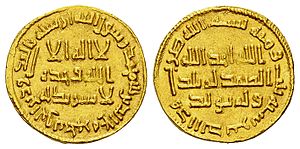Yazid II.

Yazid II. , Arabic يزيد بن عبد الملك, DMG Yazīd ibn ʿAbd al-Malik , (* 687 ; † January 26, 724 ) was the ninth caliph of the Umayyads (720-724).
The successful caliph Abd al-Malik (685-705) had a total of 16 sons, four of whom succeeded him as caliph. Yazid was one of them and came in 720 according to the testamentary agreement of his brother the caliph Sulaimān (715-717) to the successor of his cousin the caliph Umar Ibn Abd al-Aziz (717-720).
He is described by many historians as a very weak ruler who largely left the government of the caliphate to the governors in the provinces.

Due to the destruction of the Arab fleet by the Byzantine Emperor Leo III. During the siege of Constantinople (717–718) , the Arab expansion in the Mediterranean came to a standstill. Nevertheless, the Byzantine Asia Minor continued to be under great pressure even after the Arabs were repelled in 718. There were repeated raids by Arab troops in the direction of Asia Minor under Yazid II, who plundered large areas of land but withdrew again towards winter.
Under Yazid II, fighting with the Jewish Khazar Empire again took place in the Caucasus in 722 . Even when Arab troops advanced into the steppe areas north of the Caucasus, no decision was reached between the two parties. This war was to bind the Umayyad troops on the Caucasus border until 737.
Yazid II died between the ages of 33 and 40 on January 26, 724. His successors were first his brother Hischam (724-743) and then his son Al-Walid II (743-744).
Individual evidence
- ↑ Decree of the caliph Sulaimān from the year 717: In the name of God, the merciful and compassionate. This letter from the servant of God Sulaimān, commander of the believers, is addressed to ʿUmar, son of ʿAbd al-ʿAzīz. I installed you as my successor in the caliphate and as your successor Yazīd, son of ʿAbd al-Malik [...] see also: Almut Höfert: Empire and Caliphate: Imperial Monotheism in the Early and High Middle Ages. Campus Verlag, 2015, ISBN 978-3-593-50283-0 , p. 261.
literature
- Claude Cahen: Islam 1. From the origin to the beginnings of the Ottoman Empire . Fischer, Frankfurt am Main et al. 1968 ( Fischer Weltgeschichte , Volume 14).
- Ulrich Haarmann: History of the Arab World . Edited by Heinz Halm . 4th revised and expanded edition. Verlag CH Beck, Munich 2001, ISBN 3-406-47486-1 (Beck's historical library) .
- Almut Höfert: Empire and Caliphate: Imperial Monotheism in the Early and High Middle Ages. Campus Verlag, Frankfurt a. M./New York 2015, ISBN 978-3-593-50283-0
- Stephan Ronart, Nandy Ronart: Lexicon of the Arab World. A historical-political reference work. Artemis Verlag, Zurich et al. 1972, ISBN 3-7608-0138-2 .
- Gernot Rotter : The Umayyads and the Second Civil War. (680-692). Steiner, Wiesbaden 1982, ISBN 3-515-02913-3 ( Treatises for the customer of the Orient 45, 3).
- JJ Saunders: A history of Medieval Islam. Routledge & Paul, London 1965, ISBN 0-7100-2077-5 (also: Reprint. Routledge, London et al. 1990, ISBN 0-415-05914-3 ).
- Julius Wellhausen : The Arab Empire and its fall . Reimer, Berlin 1902 (reprint: 2nd unchanged edition. De Gruyter, Berlin 1960).
| predecessor | Office | successor |
|---|---|---|
| ʿUmar ibn ʿAbd al-ʿAzīz | Umayyad Caliph 720–724 |
Hisham |
| personal data | |
|---|---|
| SURNAME | Yazid II. |
| ALTERNATIVE NAMES | يزيد بن عبد الملك (Arabic) |
| BRIEF DESCRIPTION | ninth caliph of the Umayyads |
| DATE OF BIRTH | 687 |
| DATE OF DEATH | January 26, 724 |